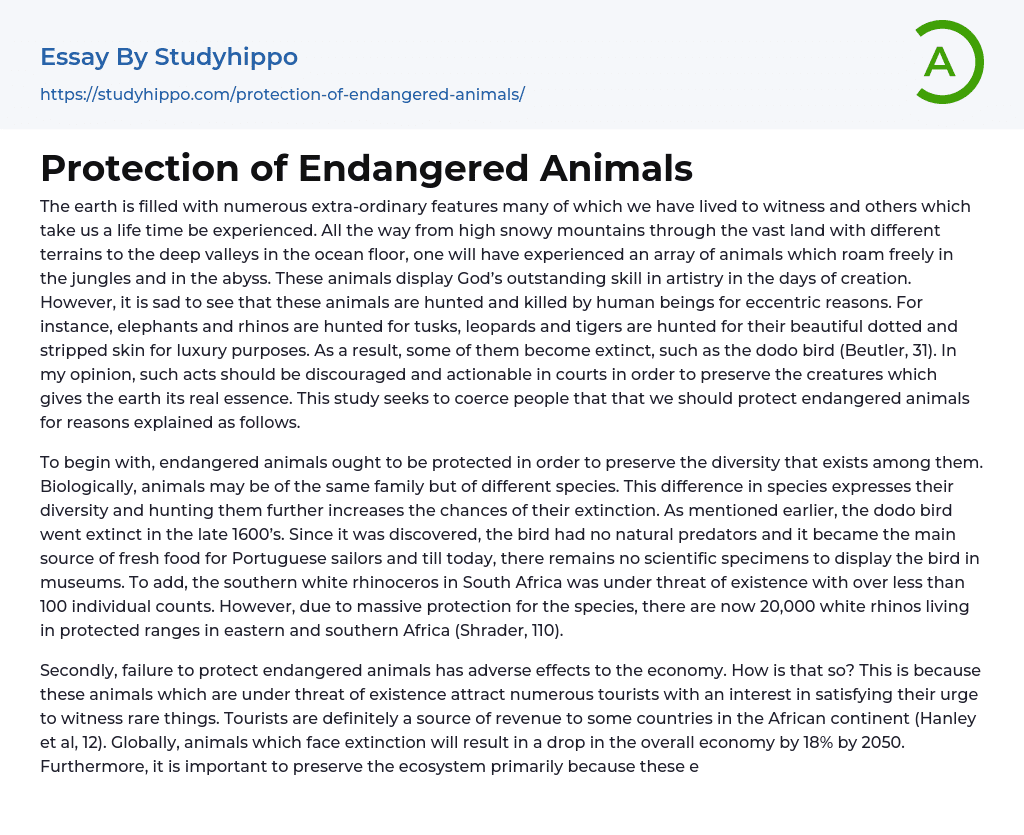The earth is filled with numerous extra-ordinary features many of which we have lived to witness and others which take us a life time be experienced. All the way from high snowy mountains through the vast land with different terrains to the deep valleys in the ocean floor, one will have experienced an array of animals which roam freely in the jungles and in the abyss. These animals display God’s outstanding skill in artistry in the days of creation. However, it is sad to see that these animals are hunted and killed by human beings for eccentric reasons. For instance, elephants and rhinos are hunted for tusks, leopards and tigers are hunted for their beautiful dotted and stripped skin for luxury purposes. As a result, some of them become extinct, such as the dodo bird (Beutler, 31). In my opinion, such acts should
...be discouraged and actionable in courts in order to preserve the creatures which gives the earth its real essence. This study seeks to coerce people that that we should protect endangered animals for reasons explained as follows.
To begin with, endangered animals ought to be protected in order to preserve the diversity that exists among them. Biologically, animals may be of the same family but of different species. This difference in species expresses their diversity and hunting them further increases the chances of their extinction. As mentioned earlier, the dodo bird went extinct in the late 1600’s. Since it was discovered, the bird had no natural predators and it became the main source of fresh food for Portuguese sailors and till today, there remains no scientific specimens to display the bird in museums.
To add, the southern white rhinoceros in South Africa was under threat of existence with over less than 100 individual counts. However, due to massive protection for the species, there are now 20,000 white rhinos living in protected ranges in eastern and southern Africa (Shrader, 110).
Secondly, failure to protect endangered animals has adverse effects to the economy. How is that so? This is because these animals which are under threat of existence attract numerous tourists with an interest in satisfying their urge to witness rare things. Tourists are definitely a source of revenue to some countries in the African continent (Hanley et al, 12). Globally, animals which face extinction will result in a drop in the overall economy by 18% by 2050. Furthermore, it is important to preserve the ecosystem primarily because these endangered animals may be of unknown benefits to human beings in the future. Who would know that the dodo bird which went extinct in the recent past may have held a cure for a core human disease today? Animals are likely to hold secrets to human diseases and they shall be soon discovered with frequent medical tests and researches held having them as the specimen. For instance, an extra significant reason for preserving the extinction of the Giant Panda is the antibacterial properties present within their blood and there is hope to develop new drugs using their blood to treat resistant bacterial diseases (Yan et al, 370).
Conclusion
To conclude, there is a dilemma when it comes to protection of endangered animals. This is because large amounts of money which are allocated so as to preserve wild animals, such as the white rhinoceros, would
have alternatively been used in solving human problems. We have heard before that some animals, dinosaurs among others, have gone extinct and it is a natural fact that extinction is a natural process. Allocating funds to preserve such animals may sound bizarre but in the long run, it would be sad, cold and heartless for us to let animals die away while we claim to have love for nature.
Works Cited
- Beutler, Larry E. "The dodo bird is extinct." Clinical Psychology: Science and Practice 9.1 (2002): 30-34. Print.
- Hanley, Nick, Jason F. Shogren, and Ben White. Introduction to Environmental Economics. , 2013. Print.
Shrader, Adrian M., et al. "Is a reduction in the individual vigilance of mothers a key evolutionary driver of group formation in white rhinos?" African Zoology 48.1 (2013): 109-114. Web. Retrieved on: 1 December 2016. Website URL: http://www.tandfonline.com/doi/abs/10.1080/15627020.2013.11407573 - Yan, Xiuwen, et al. "The cathelicidin-like peptide derived from panda genome is a potential antimicrobial peptide." Gene 492.2 (2012): 368-374. Web. Retrieved on: 30 November 2016. Website URL: http://www.sciencedirect.com/science/article/pii/S0378111911006652
- Animal Welfare essays
- Zoo essays
- Plastic essays
- Waste Management essays
- Climate Change essays
- Global Warming essays
- Conservation essays
- Recycling essays
- Air Pollution essays
- Carbon Dioxide essays
- Climate essays
- Deforestation essays
- Ecology essays
- Endangered Species essays
- Environmental Issues essays
- Environmental Protection essays
- flood essays
- Greenhouse Gas essays
- Hurricane essays
- Nature essays
- Pollution essays
- Renewable Energy essays
- Sustainability essays
- Tornado essays
- Traffic essays
- Tsunami essays
- Water Pollution essays




